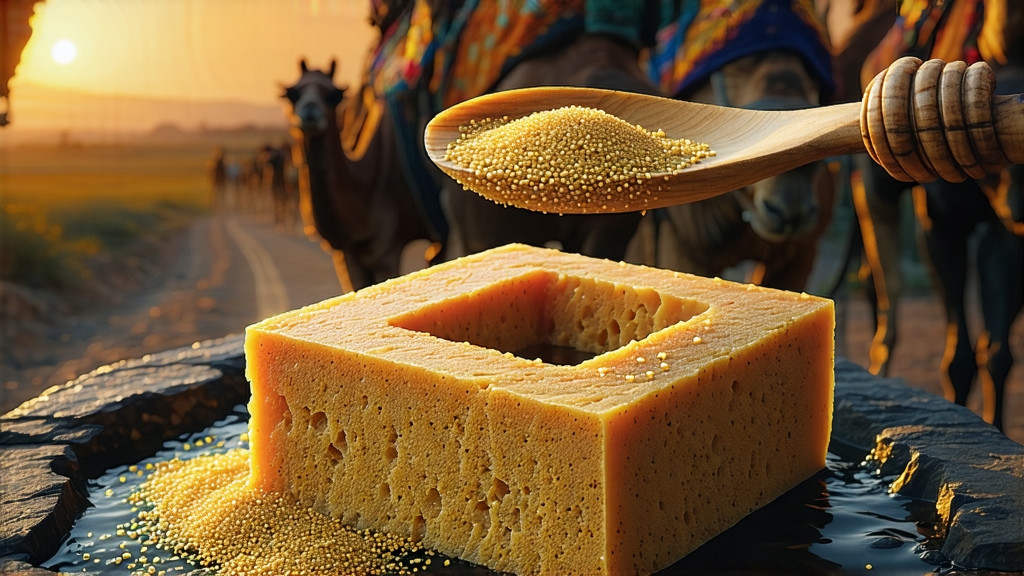
Few beverages carry the quiet gravitas of Fu brick tea (Fú zhuān chá). Compressed into obsidian-black blocks that weigh a kilogram or more, it looks almost industrial—yet once brewed it yields a liquor the color of antique amber and a flavor that slips between malt, dried jujube and the forest floor after rain. To understand Fu brick is to travel backward along the Silk Road, forward into the microbiome, and inward into the Chinese philosophy that food can be both remedy and meditation.
-
From Horse Caravans to Modern Vaults: A Brief History
During the Tang dynasty (618-907) the imperial court bartered silk for Tibetan war-horses; tea was the ballast that made the horses walk north. Compressed dark teas—low in moisture, high in durability—became the currency of this “Tea-Horse Road.” By the Ming (1368-1644) the city of Jingyang in Shaanxi province had perfected a brick whose tight density could survive the 3,000-metre altitudes of the Qinghai-Tibetan plateau. Caravaneers noticed that the bricks grew golden specks en route; the warmer, more humid climate of Hunan’s Anhua county accelerated the spotting. Thus Anhua, not Shaanxi, became the spiritual home of Fu brick around 1860. The name itself is a pun: “Fu” means both “blessing” and “Hunan,” the province whose tea was stamped with the Chinese character “Fu” for tax purposes. -
What Makes a Brick “Fu”?
Unlike other hei cha (dark teas) such as Liu Bao or Qian Liang, Fu brick must exhibit “golden flowers” (jin hua)—a velvet bloom of Eurotium cristatum visible to the naked eye as tiny yellow dots. These spores are not moldy accidents; they are cultivated with the precision a vintner reserves for Brettanomyces in wine. The flowers metabolize polysaccharides into bioactive aglycones, soften tannins, and generate a unique cycloartenol that gives Fu brick its signature mellow sweetness and lingering camphor coolness. -
Crafting the Brick: A Seasonal Symphony
Step 1: Picking
Only the 3rd–4th leaves after the Qingming festival are taken; they are mature enough to store starch yet still flexible enough to survive the rolling drum.
Step 2: Fixing
A 5-minute blast at 280 °C deactivates leaf enzymes, but—crucially—does not kill the spores already living on the surface. Think of it as opening the stage curtain while keeping the orchestra in the pit.
Step 3: First Pile-Fermentation
The leaves are heaped 70 cm high under wet cotton cloth for 24 h; temperature is allowed to rise to 55 °C. This “wet pile” (wo dui) is shorter than the 40-day Liu Bao version, because the goal is not full darkening but pre-softening.
Step 4: Rolling & Screening
A 40-minute machine twist breaks cell walls; the leaf fragments are sifted into three grades: “tips” (first sift), “flakes” (second), and “dust” (third). Only tips and flakes will enter a premium Fu brick; dust becomes instant dark-tea powder.
Step 5: Second Pile & Flower Inoculation
The semi-fermented leaf is restacked inside a steamed room kept at 28 °C and 78 % RH. Brick-makers scatter last-year’s brick crumbs—rich in Eurotium spores—like sourdough starter. Over 72 h the golden flowers germinate.
Step 6: Compression
Traditional stone molds (40 × 18 × 4 cm) are filled with 2 kg of leaf, then pressed by a lever weighted with a 200-kg river rock for 30 minutes. Hydraulic presses now duplicate the pressure, yet connoisseurs swear the slower stone press leaves air channels that allow the flowers to breathe.
Step 7: 28-Day “Flowering Warehouse”
Bricks are stacked in alternating layers of bamboo and cotton inside a cave-like storeroom. Temperature is computer-controlled at 26–30 °C; humidity cycles between 70 % (day) and 60 % (night) to mimic the original camel-caravan climate. By day 21 the golden flowers should cover 80 % of the brick’s cross-section; below 50 % and the batch is shredded for